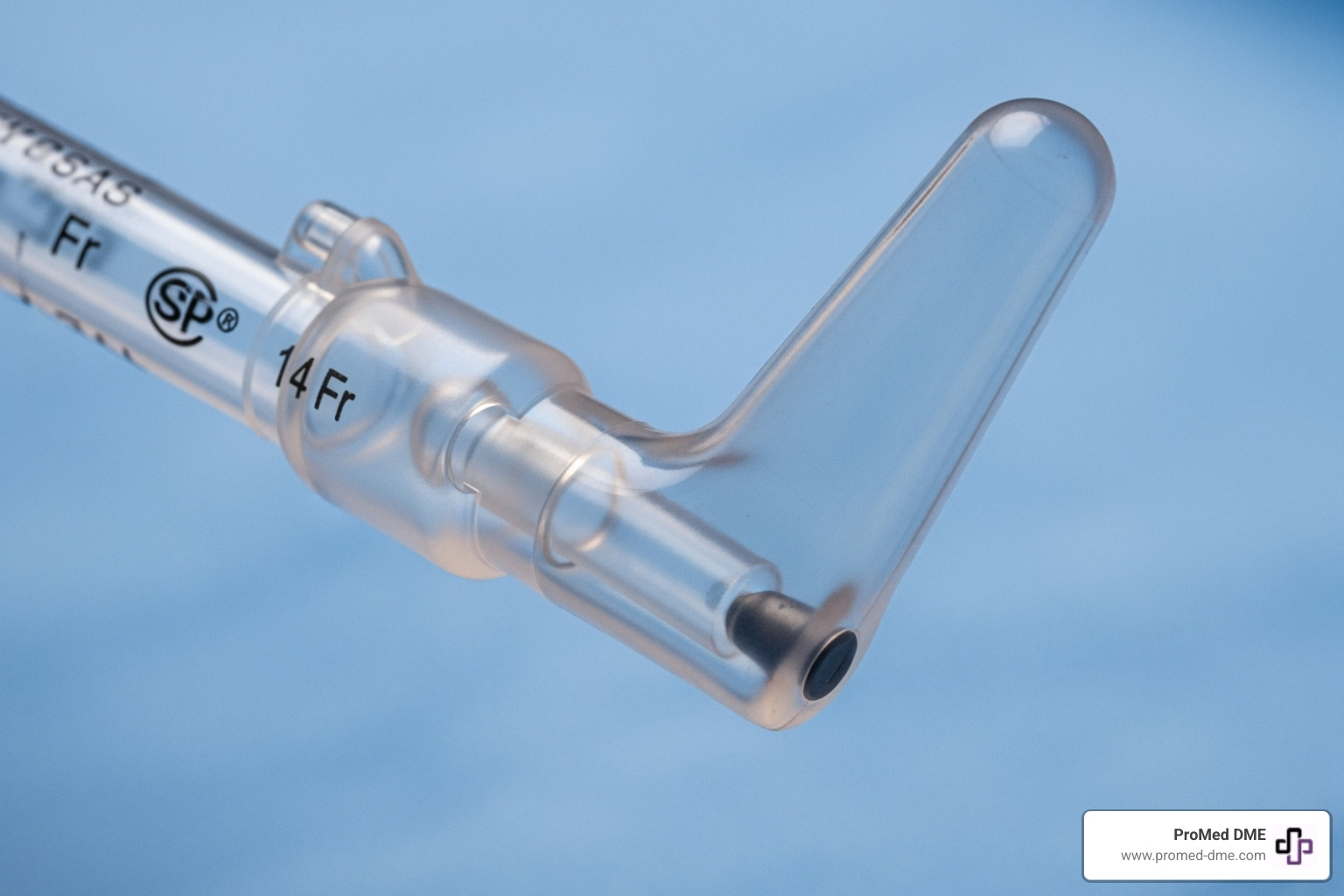Your How-To Guide for Self-Catheterization: Drain with Confidence
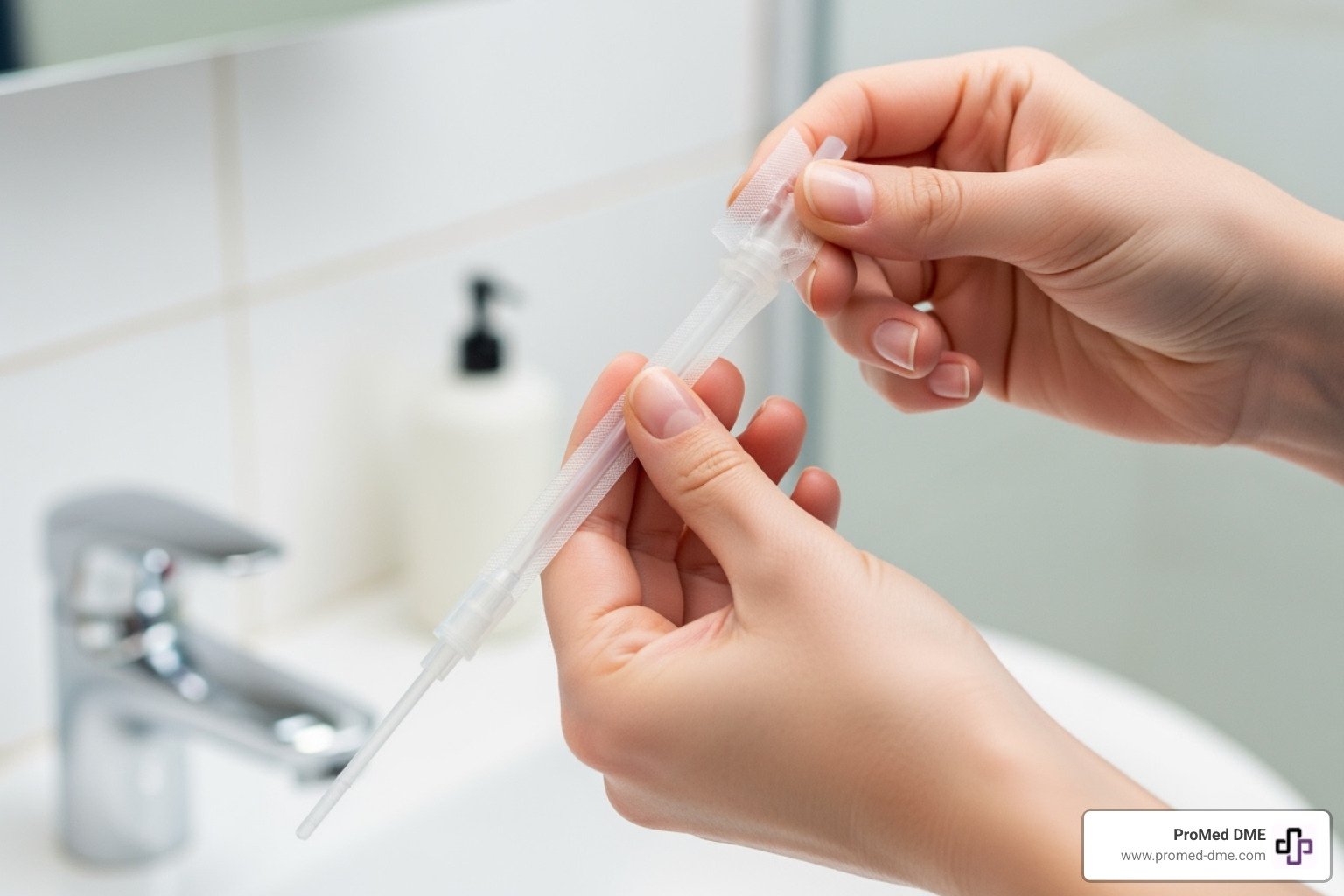
Understanding Self-Catheterization: A Path to Better Bladder Health
Self catheterization instructions help you safely empty your bladder when natural urination isn't working properly. This clean, simple procedure can dramatically improve your quality of life and prevent serious complications.
Quick Self-Catheterization Steps:
- Wash hands thoroughly with soap and water
- Clean the genital area from front to back
- Lubricate the catheter tip with water-based lubricant
- Insert the catheter gently until urine flows
- Hold until bladder is empty, then slowly remove
- Clean or dispose of catheter as directed
Self-catheterization, also called clean intermittent catheterization (CIC), becomes necessary when conditions like enlarged prostate, neurogenic bladder, spinal cord injuries, or multiple sclerosis make it difficult to empty your bladder completely.
Many people feel anxious about learning this procedure. That's completely normal. But here's the good news: most patients find that their health and daily living improve significantly with CIC. The procedure typically takes just a few minutes and becomes routine with practice.
Why is complete bladder emptying so important? When urine stays in your bladder too long, it creates the perfect environment for bacteria to grow. This leads to painful urinary tract infections and, over time, can cause permanent kidney damage.
The key is following proper technique and maintaining good hygiene. With the right supplies and clear instructions, you can perform self-catheterization safely and confidently at home, at work, or while traveling.
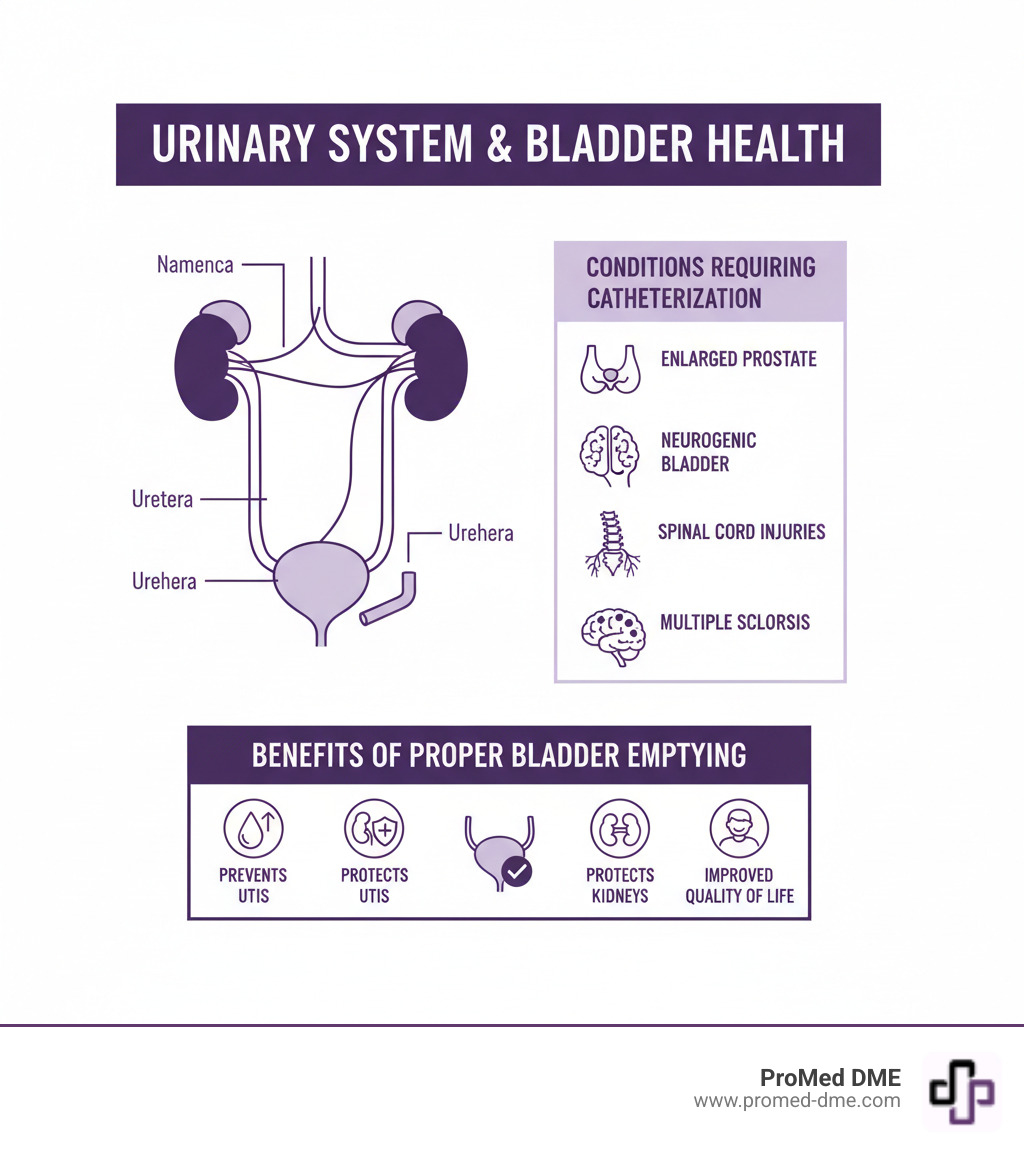
Preparing for a Safe and Clean Catheterization
Getting ready for self catheterization instructions is like setting up for any important task - having everything organized makes the whole process smoother and less stressful. Think of it as creating your own little sanctuary where you can focus on taking care of yourself properly.
The most important thing to remember is that we're working to keep bacteria out of your urinary system. This isn't about being sterile like an operating room, but rather about being clean and methodical. With a little preparation, you'll find that the whole process becomes second nature.
Your healthcare provider has given you specific instructions, and those always come first. But let's walk through the general preparation steps that make catheterization safe and comfortable for everyone.
Essential Supplies for Self-Catheterization
Before you begin, gather all your supplies in one place. There's nothing more frustrating than realizing you're missing something important halfway through the process!
Your catheter is the most important piece of equipment. Your doctor has prescribed a specific type and size just for you. Some people use straight tip catheters, while others need a coude tip catheter (that's the one with a slightly curved end that helps steer around an enlarged prostate). The sizing uses something called the French scale - you might hear your nurse mention 12, 14, or 16 French. Don't worry about memorizing this; just know that ProMed DME keeps track of exactly what you need.
Water-based lubricant like K-Y Jelly makes insertion much more comfortable. Never use petroleum jelly or anything oil-based - these don't dissolve properly and can cause problems. Some catheters come pre-lubricated, which can be really convenient, especially when you're out and about.
You'll need antiseptic wipes or mild soap and water to clean yourself before starting. Clean towels or paper towels help you dry off and create a clean surface for your supplies. If you're not catheterizing over a toilet, grab a clean container to collect the urine.
Hand sanitizer isn't absolutely necessary, but it's great to have as backup when soap and water aren't handy.
Here's a pro tip from our nursing team: always keep two or three extra catheters with you, especially when traveling. You never know when you might drop one or need a backup.
Finding the Right Position
Comfort is key when learning self catheterization instructions. When you're relaxed, your muscles are relaxed too, and that makes everything easier. Tension is your enemy here, so take a few deep breaths and find a position that feels natural.
Sitting on the toilet works great for most people because everything drains right where it should go. Sitting in a comfortable chair with a collection container works too - just make sure the container is positioned well between your legs.
Many men find standing in front of a toilet feels most natural. You can even put one foot up on a small stool or the toilet rim if that gives you better access and balance.
Women often start by lying down on their bed with knees bent and legs apart. Put a towel or waterproof pad underneath you for protection. This position gives you the best view and control when you're first learning.
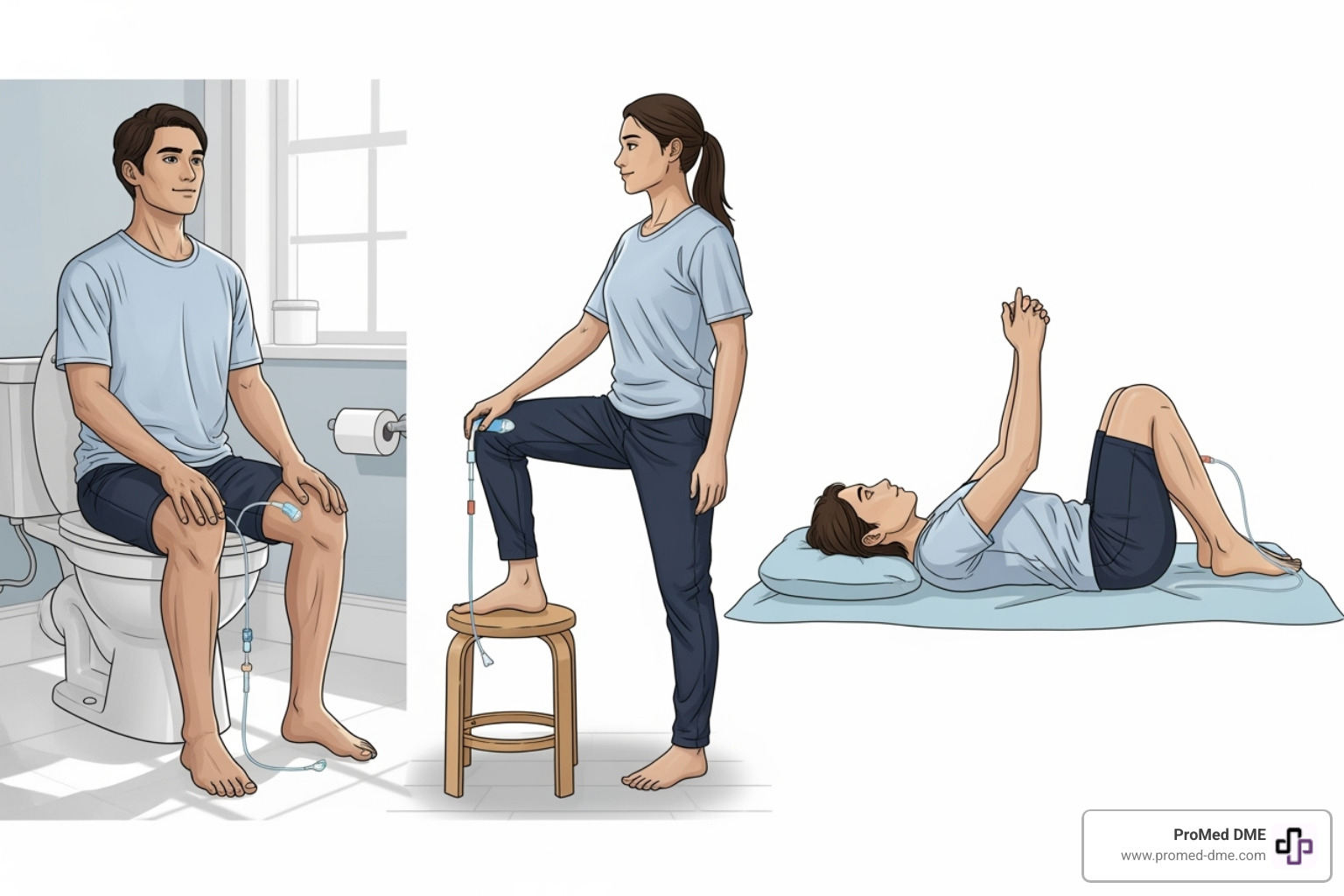
If you're a woman, a small mirror with a stand can be incredibly helpful at first. The urethral opening is small and sits right above the vaginal opening, so having that visual guide makes things much easier until you get the hang of it.
Make sure you have good lighting and complete privacy. Lock the door, turn off your phone, and give yourself permission to take your time. Keep your fingernails trimmed short and clean to avoid any accidental scratches.
Everyone feels a bit awkward when they're learning something new. That's completely normal. With practice, you'll develop your own routine and preferred position that works perfectly for your lifestyle.
Complete Self Catheterization Instructions
Now comes the moment you've been preparing for. I know it might feel overwhelming at first, but these self catheterization instructions will become as routine as brushing your teeth with a little practice. Every person I've worked with tells me the same thing: "It was much easier than I expected!"
The key is going slow, staying relaxed, and remembering that millions of people do this safely every day. Your healthcare provider has shown you their preferred technique, so always follow their specific guidance. What I'm sharing here are the general steps that work for most people.
Step-by-Step Self Catheterization Instructions for Men
Let's walk through this together, step by step. Think of me as your encouraging friend who's right there with you:
Getting Started: Begin with thorough hand washing - at least 20 seconds with soap and warm water. This isn't just a suggestion; it's your best protection against infection. No soap nearby? Alcohol-based hand sanitizer works too.
Set Up Your Space: Gather everything within arm's reach on a clean surface. There's nothing worse than realizing you forgot the lubricant when you're halfway through! You'll need your catheter, lubricant, antiseptic wipes, towel, and collection container if you're not using the toilet.
Clean the Area: If you're uncircumcised, gently pull back your foreskin first. Using an antiseptic wipe or mild soap and water, clean the tip of your penis from the urethral opening outward in a circular motion. Rinse well if using soap, then pat dry with a clean towel.
Prepare the Catheter: Here's where being gentle with yourself pays off. Open your catheter package carefully - avoid touching the tip that goes into your body. Apply a generous amount of water-based lubricant to the first 6 inches of the catheter tip. Don't be shy with the lubricant; more is definitely better than less!
Position and Insert: Hold your penis straight upward at about a 60-75 degree angle - this helps straighten your urethra. Now, slowly and gently insert the lubricated catheter into the urethral opening. Breathe deeply and try to relax your muscles.
Here's the part that surprises most men: you might feel some resistance around the 4-6 inch mark. This is completely normal! It's your sphincter muscle doing its job. Don't force it. Instead, take a deep breath, cough lightly, or slightly adjust the angle. The resistance usually releases, and the catheter slides in smoothly.
Complete the Drainage: Continue advancing the catheter until you see urine flowing - usually after about 7-9 inches. Once urine starts flowing, push the catheter in another 1-2 inches to ensure it's fully in your bladder. Let all the urine drain completely. You might need to gently press on your lower abdomen or lean forward slightly to empty everything.
Gentle Removal: When the flow stops completely, slowly remove the catheter. If more urine comes out as you're removing it, that's normal - just pause and let it finish draining.
Finish Up: If you're uncircumcised, pull your foreskin back over the head of your penis. Wash your hands again, dispose of single-use catheters, and clean reusable ones as we'll discuss later.
Don't worry if your penis feels slightly irritated at first - this is completely normal when you're learning. For additional detailed guidance, the Memorial Sloan Kettering Cancer Center website and Spokane Urology's male self-catheterization guide offer excellent resources.
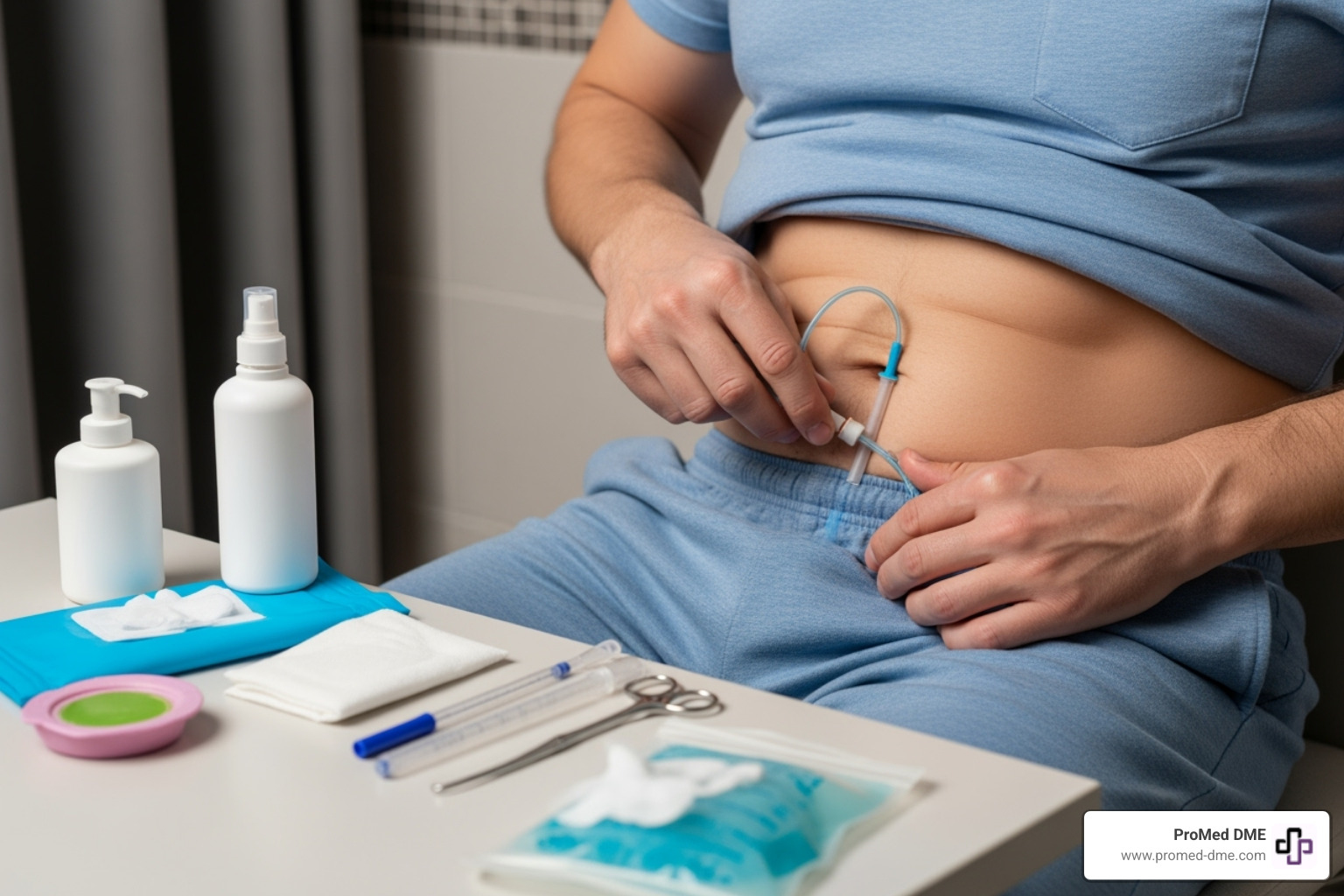
Step-by-Step Self Catheterization Instructions for Women
For women, the biggest challenge is usually locating the urethral opening accurately. Once you've got that down, the rest flows smoothly. Let me guide you through it:
Hand Hygiene First: Just like with men, start with thorough hand washing for at least 20 seconds. This simple step prevents most complications, so don't skip it even when you're in a hurry.
Get Comfortable: Find your preferred position and stick with it while you're learning. Many women love sitting on the toilet because it's convenient and private. Others prefer sitting in a chair with legs spread, or lying on their back with knees bent. Whatever feels most natural for you is perfect.
Find Your Landmarks: This is where that small mirror becomes your best friend! Your urethral opening is a tiny hole located above your vaginal opening and below your clitoris. It's smaller than you might expect, so don't feel frustrated if it takes a few tries to locate it confidently.
Clean Thoroughly: With one hand, gently separate your labia. Using an antiseptic wipe or mild soap and water, clean around your urethral area. Always wipe from front to back - this prevents bacteria from your rectal area from traveling toward your urethra.
Lubricate Generously: Open your catheter package without touching the insertion tip. Apply plenty of water-based lubricant to the first 3 inches of the catheter. Comfort is key, and good lubrication makes all the difference.
Gentle Insertion: While holding your labia apart with one hand, slowly insert the lubricated catheter into your urethral opening at a slight upward angle. The angle matters - aim toward your belly button rather than straight back.
Advance and Drain: Continue pushing the catheter gently about 3 inches until urine begins flowing. Once you see urine, advance the catheter another inch to ensure it's fully in your bladder. Hold it steady and let everything drain completely.
Careful Removal: When urine stops flowing, pinch the catheter closed to prevent drips, then slowly and gently remove it. This pinching technique is a game-changer for staying comfortable and clean.
Clean Up: Wash your hands thoroughly, dispose of single-use catheters properly, and clean reusable ones according to the instructions we'll cover next.
I promise it gets easier! Most women tell me they feel confident after just a few attempts. For additional support and detailed visuals, check out resources from Brigham and Women's Hospital.
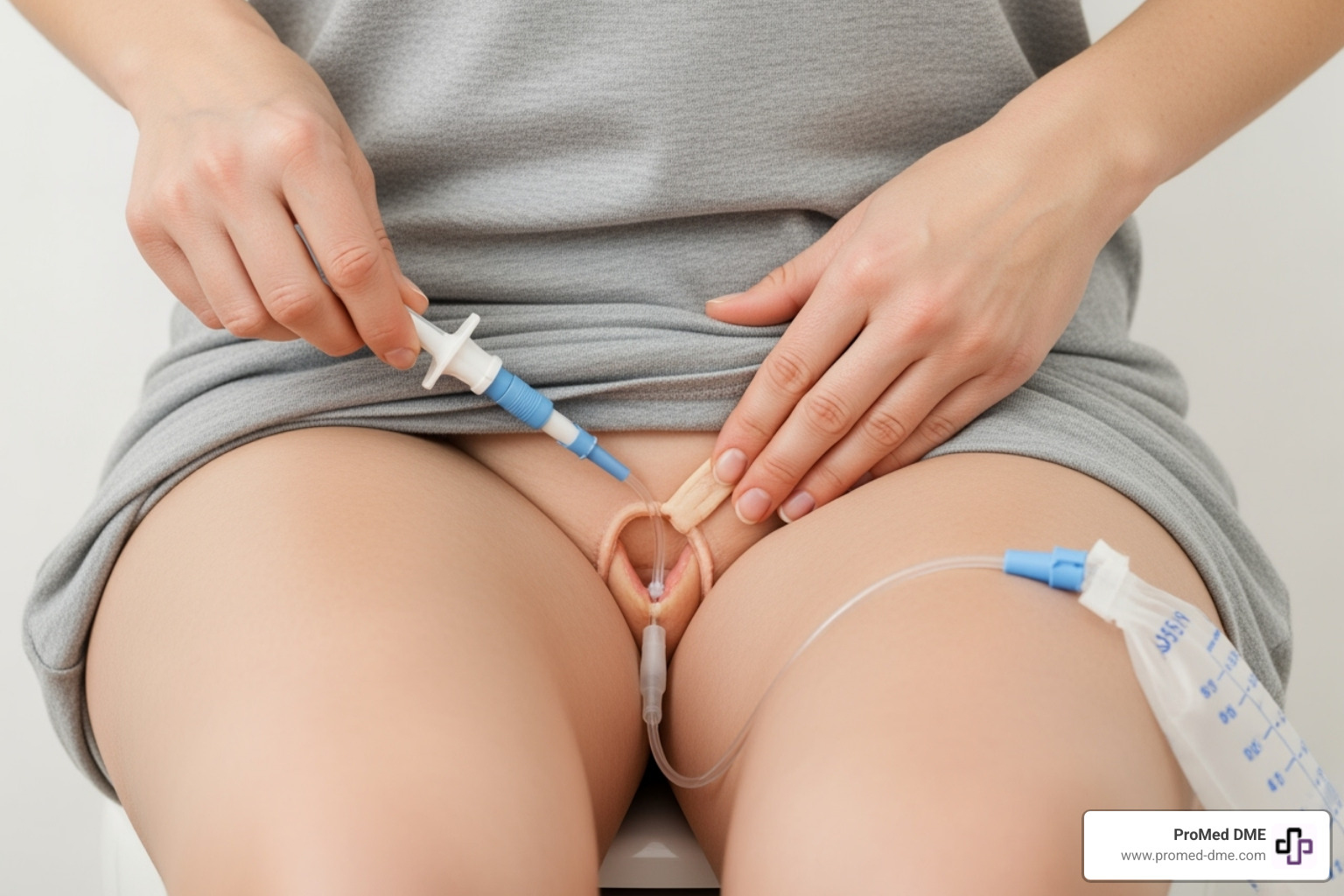
Aftercare, Cleaning, and Troubleshooting
Taking proper care of yourself and your equipment after catheterization is just as important as the procedure itself. Think of it as the final step that keeps everything running smoothly and helps prevent complications down the road.
Always wash your hands thoroughly with soap and water immediately after completing your self catheterization instructions. This simple step helps prevent spreading any potential germs and keeps you healthy.
Your catheter type determines what happens next. Disposable catheters are designed for one-time use only – simply throw them in the trash after use. Reusable catheters, on the other hand, need proper cleaning and storage to maintain hygiene and extend their lifespan safely.
For those who travel frequently or want to be prepared anywhere, consider putting together a small travel kit. Pack a catheter, a small package of lubricant, and a pre-moistened wipe in a zip-lock bag. This ensures you're always ready, whether you're at work, visiting family, or exploring new places.
How to Clean and Store Reusable Catheters
If your healthcare provider has recommended reusable catheters, proper cleaning and storage become essential for preventing infections. Here's how to care for them properly:
Start cleaning immediately after removing the catheter. Wash it thoroughly with warm water and mild antibacterial soap. You can use a clean, 60 mL catheter-tip syringe or squeeze bottle to flush water through the catheter's inside. Pay special attention to the drainage holes (called "eyes") to ensure no residue remains.
Rinse completely under clean, running water to remove all soap residue. Any leftover soap can cause irritation during your next use.
Allow the catheter to air dry completely. You can hang it up or lay it on a clean paper towel. Avoid using cloth towels, which can harbor bacteria even when they look clean.
Store only when completely dry in a clean, sealed container, zip-locked bag, or clean paper bag. Never store a wet catheter in a closed container – this creates the perfect environment for bacterial growth.
Replace your reusable catheter regularly. They typically last 2 to 4 weeks, but should be discarded sooner if they show any signs of wear, damage, discoloration, or if the plastic looks cloudy or becomes brittle. Always follow your healthcare provider's specific replacement schedule.
Common Issues and When to Call a Doctor
Even when following proper self catheterization instructions carefully, you might encounter some common issues. Knowing how to handle them – and when to seek medical help – keeps you safe and confident.
Difficulty inserting the catheter often means you need more lubrication or need to relax more. Try taking deep breaths, using more lubricant, or gently adjusting your position. Sometimes a warm shower beforehand can help you relax.
Resistance during insertion is usually your sphincter muscle tightening up. This is normal, especially when you're learning. Try coughing gently, taking a deep breath, or pausing for a moment before continuing slowly.
No urine flow after insertion might mean the catheter isn't positioned correctly in your bladder. Try advancing it slightly further, or gently moving it in and out a small amount. You can also try pressing gently on your lower abdomen or leaning forward.
Minor bleeding like pink-tinged urine or a small amount of blood on the catheter can happen, especially when you're new to the process. This usually results from minor irritation. Make sure you're using enough lubricant and being gentle. The bleeding should decrease as you become more experienced.
Pain during catheterization isn't normal and shouldn't be ignored. It could indicate improper technique, inadequate lubrication, or a medical issue like a urinary tract infection.
Call your healthcare provider immediately if you experience heavy bleeding, persistent bleeding, blood clots in your urine, severe pain, signs of infection (fever, chills, cloudy or foul-smelling urine), or pelvic pain. These symptoms require prompt medical attention.
Minor discomfort when learning is normal, but significant pain or concerning symptoms should never be ignored. When in doubt, it's always better to contact your healthcare team for guidance.
Related Resources & Articles
Stay informed with our informative blog posts.
Discover the ProMed Advantage
& Try Our Products
We offer free shipping and legendary customer service to ensure you receive the
best DME products for your needs.


